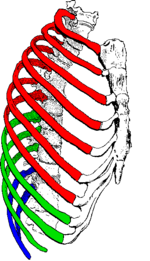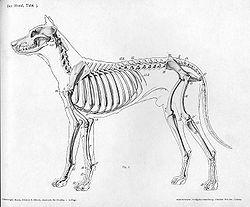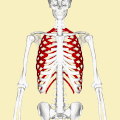Rib
In vertebrate anatomy, the ribs are flat, curved bones that together form the rib cage. In most vertebrates they surround the chest, allowing those with lungs to expand them, making breathing easier. In general, they serve as protection for the internal organs of the thorax, such as the heart, although in some species, especially snakes, they provide support and protection for almost the entire body.
In humans
Human ribs are generally 12 on each side (24 in total): 7 true or sternal (I-VII), 3 false or sternal (VIII-X), and 2 floating (XI and XII), shaped like arch with a body with two faces, external and internal; two borders, upper and lower; and two ends, posterior and anterior.
They are found in the thorax, made up of cartilage in the most medial part of its anterior aspect and bone in its lateral and posterior aspects, which make up the most visible part of the bone framework of the ribcage, giving it a cage-like appearance, which articulate with each of the twelve dorsal or thoracic vertebrae in the posterior part and with the sternum, through the corresponding costal cartilage, in the anterior part.
Inside the rib cage are the lungs and the mediastinum. In this is located the heart, esophagus, trachea, lymph nodes, thymus, aorta, superior and inferior vena cava.
Anatomy
All the ribs join at the back of the thoracic vertebrae.
The spaces between the ribs are known as the intercostal spaces, in which you can find the intercostal muscles, intercostal arteries, and nerves.
The basic structures of a rib are:
- Head: Internal part of the back of the rib; it is articulated with the corresponding chest vertebrae and with the vertebrae on it, except for the first and the last two, which are articulated only with their corresponding vertebrae. It is the most voluminous end of the bone, where there is a joint to the spine.
- Neck.: A narrow bone portion that joins the head.
- Body: Main part of the rib. Here the iliocostal muscle is inserted.
- Tube: The tuber of the rib is an eminence on the back surface, at the cross of the neck and the body of the rib. All typical ribs (3rd to 9th) have a joint rib with the transverse process of chest vertebrae. In the case of floating ribs, they lack this joint surface.
- Anglo: The separation between the angle and the tube is progressively greater than the second to the tenth ribs. The portion between the angle and the tube is round, rough and irregular, and serves for the insertion of the dorsal muscle tooth thoracic vertebra; this tuber is missing in the last 3 pairs of ribs.
- Surco: It is the concavity between the edge of the inner face with the lower edge, where the intercostal neuro-vascular package passes (arteries, veins and intercostal nerves). The respective intercostal muscles are also inserted.
- Cresta: Rib structure that is located in the head of some ribs.
All ribs have an external and internal face, except for the first rib, which has a superior and inferior face. The Lisfranc tubercle is found on the anterior arch of the first rib, where the anterior scalene muscle inserts.
Classification
- Cervicals: United to the seventh cervical vertebrae, they are vestiges in the human being, being present (usually only one) in 0.2% of the world's population.
- Sternal: They bind directly to the sternon, the one responsible for this is the rib cartilage, which binds these ribs with the stern.
- Asternal: They bind themselves indirectly to the stern, first joining the rib cartilage of the seventh rib.
- Fleet: They are not attached to the breastbone
In other species
Fish often have two sets of ribs attached to the backbone. The first, of the dorsal ribs, are located in the septum that divides the main muscle groups into their upper and lower portions, projecting laterally from the vertebral column. The second group is the ventral ribs, which arise from the vertebral column just below the dorsal ribs and enclose the lower part of the body, often joining at the tips. Not all species possess both types, the dorsal being the most commonly absent. Sharks, for example, have no dorsal ribs, and only very short ventral ribs, while lampreys have no ribs at all. In some teleosts there may be some rib-like bones in the muscle mass.
In tetrapods there is only one type of rib, which is probably homologous with the dorsal ribs of fish. In early tetrapods each vertebra had a pair of ribs, although those of the thoracic vertebrae were typically longer. Those of the sacral vertebrae were shorter, and formed part of the pelvis.
In most subsequent forms many of the primordial ribs have been lost, there being in living species of amphibians and reptiles a great variety in their structure and number. Turtles, for example, only have 8 pairs of ribs, which have evolved into a bony or cartilaginous shell, while snakes can have hundreds of ribs, covering the entire length of their trunk. Frogs typically have no ribs, apart from a sacral pair, which forms part of the pelvis.
In birds, the ribs appear as distinguishable bones only in the thoracic area, having some small ribs fused with the cervical vertebrae. The thoracic ribs provide great protection in the dorsal area, presenting an uncinate process to support the shoulder muscles.
Mammals usually only have thoracic ribs, although there are fused cervical ribs in monotremes. In marsupials and placentals the lumbar and cervical ribs are only small remnants, being referred to as transverse processes. In general, the structure and number of ribs in mammals is similar to that of humans. Unlike reptiles, caudal ribs never appear in mammals.
Mammals, such as the horse has 18 to 19 ribs and the dog 13; In other words, the number of ribs is influenced by the number of thoracic vertebrae, which articulate the bony part of the rib, so the number varies depending on the species. The ribs also serve to protect some organs such as the heart, lungs, etc.
Gallery
Contenido relacionado
Natural Sciences
Posidoniaceae
Calathea








